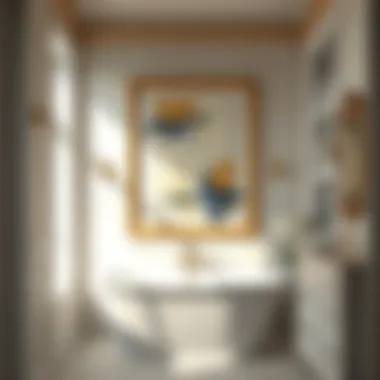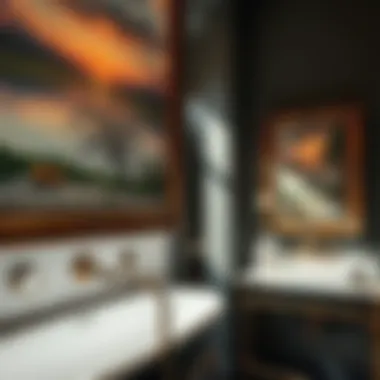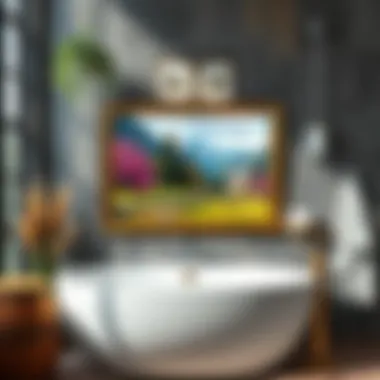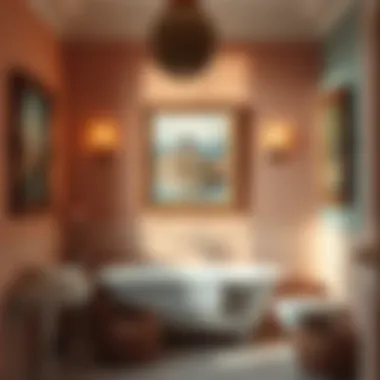The Art of Framing: Bathroom Paintings and Impact


Intro
When we think about bathroom decor, it’s easy to overlook the walls, often plain and bare. However, the beauty of incorporating framed paintings into this intimate space can’t be overstated. A carefully curated piece of artwork can elevate a simple bathroom into a sanctuary, merging utility with artful elegance. The art you choose not only reflects personal style but also sets the mood—whether it’s a tranquil escape or a vibrant energy. As we delve deeper into the world of bathroom paintings and their aesthetic impact, we’ll explore how to make these artistic choices wisely and what materials can take your space from mundane to magnificent.
Understanding the Role of Art in Bathroom Design
Art plays a unique role in bathroom design, often overlooked when homeowners focus solely on functionality and space efficiency. The bathroom, a personal sanctuary, offers an opportunity to express taste through the clever placement of paintings and other artwork. Think of art here not just as decoration, but as an enhancer—something that shifts the mood as soon as you step inside.
Defining the Bathroom Space
When we think of a bathroom, it’s easy to conjure images of sterile tiles and plain colors. However, defining this space goes beyond just its physical boundaries. A bathroom can be a place for relaxation or a quick refresh before a busy day. Understanding its purpose is essential.
For example, consider a tranquil getaway brightened by light greens and soft blues. Here, art becomes a pivotal element. Rather than merely hanging a random picture, selecting a piece that reflects the desired ambiance—like a serene landscape or delicate floral artwork—can transform a clinical washroom into a calming retreat. By strategically defining the bathroom space with the right artwork, homeowners can create a sensory experience.
Aesthetics vs. Functionality
It's a bit of a tightrope walk, finding a balance between aesthetics and functionality. On one hand, the bathroom should serve its practical purposes without a hitch. On the other, who says it can't be a feast for the eyes?
While considering the layout, think about how a painting can complement the room's fixtures and color scheme. An abstract piece might clash with rustic vintage tiles, for instance, so it's crucial to choose art that harmonizes with existing decor. Moreover, paintings can also be a reflection of you. Picture this: a bold, vibrant painting over the bathtub brings life to a minimalist design. The choices you make here can elevate the entire space, making it more inviting and personal.
"Art in the bathroom is not just about adding beauty; it’s about enhancing the overall experience of the space."
In reality, each piece you choose should resonate with the feeling you want to evoke, maintaining both its function and aesthetic appeal. Whether it's through soothing watercolor washes or striking modern designs, the careful consideration of art's role in the bathroom can lead to spaces that feel both practical and inspirational.
Types of Paintings Suitable for Bathrooms
When selecting artwork for bathrooms, understanding the specific types of paintings that complement the space is paramount. The bathroom is often perceived as a haven for relaxation and rejuvenation. Choosing the right art can enhance that sense of tranquility while also adding visual interest. Not every painting will suit the unique environment of a bathroom, due to factors like humidity and available space. It's essential to consider not just aesthetics but also durability and moisture resistance when making selections.
In this section, we delve into three diverse styles of paintings that work particularly well in bathroom settings. Each style brings its own flavor and can significantly influence the ambiance of this often-overlooked room in the house.
Nature-themed Artwork
Nature-themed artwork can transport viewers into serene landscapes and peaceful outdoor vistas, making it an excellent choice for bathroom decor. This genre of art tends to evoke feelings of calm and tranquility, mimicking the refreshing sensations often associated with nature. Images of delicate flowers, sweeping mountains, or tranquil seascapes can inspire a sense of peace, making them perfect companions for a relaxing bath.
Benefits of Nature-themed Artwork:
- Enhances Relaxation: The imagery can create a spa-like atmosphere, encouraging relaxation.
- Works Well with Colors: Nature paintings often utilize greens, blues, and soft earth tones, harmonizing beautifully with a typical bathroom color palette.
- Versatility: Suitable for various decor styles, whether modern or traditional.
When selecting nature-themed art, ensure that the material is suitable for humid environments. Look for prints under glass or water-resistant canvas, which will endure the bathroom’s conditions without significant wear.
Abstract Art Choices
Abstract art offers unique flexibility in bathroom decor. It allows for personal interpretation, enabling homeowners to express their individuality. The non-representational nature of abstract paintings can create stimulating focal points, drawing the eye and igniting curiosity. Additionally, abstract art can introduce dynamic colors and shapes that enliven an otherwise mundane setting.
Considerations with Abstract Art:


- Color Explosion: Abstract pieces can complement or contrast the existing bathroom colors, creating an exciting visual dialogue.
- Personal Connection: Art that's open to interpretation might resonate differently with each viewer, making it a conversation starter in your domestic space.
- Scale Matters: Large abstract pieces can yield dramatic effects, while smaller ones might work well in group arrangements.
Keep in mind the balance between complexity and simplicity in abstract designs. Oversaturated artworks may overwhelm a small bathroom, while minimalist pieces could offer a tranquil counterbalance.
Classic and Traditional Options
Classic and traditional artworks bring a timeless elegance to the bathroom. Portraits, landscapes, or well-known classical imagery can infuse the space with a sense of history and sophistication. These types of paintings evoke a sense of nostalgia, making the bathroom feel less utilitarian and more like a curated space within the home.
Pros of Classic and Traditional Artworks:
- Timeless Appeal: Classic pieces do not go out of style, ensuring longevity in your decor selection.
- Formal Touch: Adding traditional artwork can elevate the overall sophistication of your bathroom space.
- Diverse Styles: You can find classic pieces that range from Victorian to Baroque, providing ample choice to fit your design scheme.
Framing classic pieces with appropriate moldings can significantly enhance their visual impact. A well-chosen frame tailored to the artwork can work wonders in harmonizing with other elements in your bathroom.
Framing Techniques That Enhance Bathroom Art
Framing techniques play a crucial role in the overall aesthetic of bathroom artwork. A well-chosen frame can transform a simple painting into a focal point, serving not just as a decorative element but also as a shield against moisture. Selecting the right frame adds depth to the piece and harmonizes it with the bathroom's decor. It's about finding that sweet spot where art meets functionality, especially in a setting known for its unique challenges.
Understanding Frame Materials
When it comes to materials, the options are plentiful, but not all are suitable for a bathroom environment. Wood frames, while classic and warm, can warp or swell when exposed to high humidity. A more suitable option is plastic or metal. Both are water-resistant and can withstand the dampness commonly found in bathrooms. For example, aluminum frames offer a sleek and modern look, while resin frames can mimic the elegance of wood without the downside.
Here’s a quick rundown:
- Wood: Aesthetic but risk of damage from moisture.
- Metal: Durable and easy to clean.
- Plastic: Affordable and moisture-resistant.
Choosing the appropriate material is essential, as this decision affects not only the durability of the artwork but also the overall vibe of the space.
Choosing the Right Size and Proportion
Size matters, especially in small spaces like bathrooms where every inch counts. A large painting can draw the eye and create the illusion of more room, while smaller pieces may create a cluttered appearance if not arranged well. When selecting a frame, consider the size of the wall where it will hang. A confined space can benefit from artwork that is proportionate, rather than overwhelming the area.
Keep in mind the following tips:
- Aim for a 3/4 ratio of space between the artwork and surrounding fixtures.
- Use a mix of sizes to create visual interest, but keep the theme consistent.
- Pay attention to how the piece interacts with other elements in the room, like mirrors or sinks.
The right size and proportion create balance, making the bathroom feel more harmonious and inviting.
Matting Options to Consider
Matting can serve as a subtle but powerful enhancement to the artwork. It provides a border that can add depth and contrast to the framed piece. When done right, matting not only emphasizes the artwork but also protects it from any direct contact with the glass, which can cause damage over time.
When pondering matting options, consider:
- Color Choices: A white mat can create a clean look, while a darker mat can add drama and elegance.
- Width: Wider mats can give a contemporary feel, while narrower mats keep things traditional.
- Texture: Different textures play a role too, like a linen mat, which can add a tactile element to the visual composition.


Incorporating matting appropriately can elevate the overall appearance of your artwork. It brings a sense of completeness and professionalism to your bathroom decor, making any art piece pop.
"A well-framed piece is like icing on a cake—it pulls everything together in a way that’s pleasing to the eye."
In summary, when enhancing your bathroom art, the frame materials, sizes, and matting options are not just technical details; they contribute profoundly to the overall ambiance you wish to create. Investing time in selecting the right framing techniques will not only beautify your bathroom but will also provide lasting enjoyment of your chosen artwork.
Color Psychology in Bathroom Art
In the context of bathroom decor, color plays a significant role that goes far beyond mere aesthetics. It has the power to influence emotions, enhance comfort, and create an atmosphere conducive to relaxation or energization, as desired. Understanding color psychology in the realm of bathroom artwork is critical, as it can transform an ordinary space into a personal sanctuary. When selecting framed paintings, understanding the hues and their psychological impacts can help in crafting a calming retreat or a vibrant energizer, depending on individual preferences.
Impact of Color Choices
Choosing the right colors for bathroom artworks can greatly influence the ambiance of the space. Three primary color groups often emerge as popular choices for bathroom paintinfs: cool tones, warm tones, and neutral colors.
- Cool Tones – Shades like blues, greens, and purples evoke tranquility and calmness. These colors are reminiscent of water and nature, making them particularly fitting for a bathroom. For instance, a serene blue abstract art piece can create a coastal feel, making the space feel refreshing and open.
- Warm Tones – Colors like reds, oranges, and yellows can inject energy and liveliness into the bathroom. While perhaps less common, a warm-toned painting can be effectively used to energize the space for a jolting morning routine. An example might be a vibrant sunset painting that sparks warmth and enthusiasm.
- Neutral Colors – Shades of beige, gray, and whites are versatile and can create a harmonious backdrop. They allow for ease in mixing and matching with different decorative accents. A minimalist black-and-white piece can enhance modern decor, maintaining a sleek and tidy feel.
"A carefully chosen color palette can be the difference between a bathroom that feels cold and clinical versus one that feels inviting and warm."
Harmonizing with Existing Decor
Integrating bathroom artwork effectively means also considering the existing decor when making artistic choices. Here are some key considerations:
- Color Coordination – Paintings should complement or contrast with the colors used in towels, tiles, and cabinetry. If the tiles boast a soft gray, consider paintings with hints of cool colors or varied shades of gray to pull the entire look together seamlessly.
- Theme Matching – Aligning the artwork with the overall bathroom theme can create a more cohesive look. A coastal-themed bathroom could beautifully incorporate nature paintings featuring seashells, waves, and beach landscapes.
- Texture Consideration – Different framed paintings introduce various textures. If walls feature smooth tiles or glass, opt for paintings that offer a touch of texture through brush strokes or frame choices, balancing the overall feel.
- Size and Scale – The dimensions of the artwork in relation to bathroom size greatly affects the visual impact. A sizable piece over a tub can serve as a focal point, while smaller pieces grouped together can create a gallery wall effect, making the space feel personalized.
- Lighting Effects – The way light interacts with colors is crucial. Soft, diffused lighting can enhance cooler artworks, while direct light can highlight the vibrancy of warmer colors. The placement of paintings in relation to natural and artificial lighting can alter the mood even further.
Practical Considerations for Bathroom Artwork
When diving into the world of bathroom decor, artwork selection is not merely a matter of taste; it’s also a smart interplay of various factors. The bathroom, while a small space compared to the rest of your home, carries its own set of challenges and unique features that shape the type of art that can be effectively utilized. First and foremost, it is important to recognize that bathrooms tend to experience higher levels of humidity and moisture exposure than other rooms. This context makes it crucial to choose art that can withstand these conditions and won’t deteriorate quickly.
Furthermore, maintenance is another practical consideration. Bathroom artwork needs regular upkeep, which can be an afterthought if not planned for ahead of time. Additionally, how and where the art is placed plays a vital role in its longevity and aesthetic appeal. Balancing excellent art choices with practical considerations will ensure that your bathroom remains an inviting retreat without the stress of damaged or inappropriate decor.
Humidity and Its Effects
Humidity can be a silent enemy to bathroom artwork, particularly for pieces that aren’t designed for damp conditions. In rooms where steam rises and droplets linger, standard matted or paper-based prints may warp, mold, or discolor. Choosing materials that stand the test of humidity is a must. Look for:
- Canvas prints: These tend to hold up better against moisture compared to paper.
- Framed pieces with glass: They offer protection, preventing water from directly impacting the artwork.
- Art created on wood or metal: These materials often resist mold and mildew, making them ideal for bathroom spaces.
Moreover, consider the climate your bathroom is subjected to. Is it well-ventilated or does it get stuffy? Each factor affects the artwork's durability. Instead, if you decide to display more delicate artwork, make sure to place it where it is less exposed to direct moisture, perhaps further away from the shower or tub.
Maintenance and Cleaning of Art
Regular maintenance of your bathroom artwork not only preserve its look but also prolongs its life. Depending on your choice of art, cleaning methods may vary:
- For plastic-framed prints, a gentle wipe with a damp cloth can be all it needs.
- Canvas pieces require a bit more care; use a soft brush to dust off dirt, avoiding direct moisture.
- If you've invested in mixed media artworks, refer to the artist's recommendations for cleaning. Always test products in a small, inconspicuous area first to avoid damage.
It’s equally prudent to ensure your bathroom has adequate ventilation. This helps decrease humidity levels, reducing the chance of mold and moisture build-up, which could otherwise deteriorate your artwork faster than you’d like.


Placement and Installation Tips
The location of your artwork can make or break its charm in the bathroom. As a primary rule, never just slap artwork on the nearest wall without considering its visual impact. Instead, think about:
- Height: Aim for eye-level viewing so that each piece can be appreciated. This means installing art roughly between 57-60 inches off the ground, the general standard for gallery installations.
- Light exposure: Avoid direct sunlight; bathrooms often have natural light, but you don't want your art to fade over time. You might want to position them in an area that is not directly in path of sunlight beams.
- Theme cohesion: Ensure the selected art complements the bathroom's overall decor theme. For instance, if your bathroom boasts a coastal vibe, go for art that reflects marine life or beach scenes.
Elevating the Ambiance with Art
Incorporating art into a bathroom setting serves not merely as a decorative choice but becomes intrinsic to creating an inviting atmosphere. The bathroom is often perceived as a functional space, but with thoughtful design, it can transform into a sanctuary—a place for self-care and relaxation. Utilizing framed paintings as focal points can have significant impact. They can not only amplify aesthetic appeal but also evoke certain moods or feelings that enhance the overall experience.
Creating a Relaxation Zone
Imagine stepping into your bathroom after a long day, the light softly filtering through sheer curtains, and earthy tones surrounding you. Art plays a key role in crafting this vibe. Choosing serene illustrations, such as peaceful landscapes or calming abstracts, helps set the right tone, encouraging a feeling of tranquility.
- Selecting pieces that depict nature can create connections to the outside, filling the room with a breath of fresh air.
- Soft colors like blues, greens, and muted pastels tend to soothe the senses, making them ideal choices for bathroom art.
- Hang paintings at eye level to draw attention without overwhelming the visual space. The act of noticing art can inherently bring a sense of calmness.
Equally important are the materials and framing directly related to the artwork. Opt for frames that are moisture-resistant, as a bathroom often incurs humidity. Wood or certain metals can enhance the relaxing atmosphere while still standing up to the unique challenges of a bathroom environment.
Using Art to Make a Statement
Art also acts as a powerful conversation starter. A striking piece can inject personality and flair into your bathroom that resonates with your individual style. This sets the stage for more than just a visit for hygiene, but cultivates an experience.
- Bold colors can be utilized to create energetic focal points against calmer backgrounds.
- Opt for quirky or unconventional pieces that don’t necessarily fit conventional decor standards—this could be a vintage travel poster or a vibrant pop-art mural.
- Displaying works from local artists not only supports the community but also promotes unique narratives within your space.
"Art is the most beautiful of all lies, yet lies that tell the truth." This old adage highlights art’s ability to express and communicate, enhancing the ambiance in ways one might not immediately grasp.
In essence, whether aiming for peace or pizzazz, the right artwork can validate the bathroom as an important segment of your home. The artwork you choose can indeed elevate the experience, making even a mundane routine feel more like a retreat.
Mixing and Matching Art Styles
When it comes to dressing up your bathroom with art, the mixing and matching of styles provides a fascinating playground for expression. Art can shape a bathroom’s vibe, transforming it from a mere utility room into a personal sanctuary. The contrast of various styles can highlight individual tastes while giving the room a unique charm that appeals to the eye.
Eclectic Approaches to Bathroom Decor
Embracing an eclectic approach in your bathroom decor means playing with colors, shapes, and themes that might not traditionally go hand in hand. Think about integrating a bright, bold painting of an abstract landscape with delicate, vintage frames from your grandmother’s attic. By juxtaposing new and old, contemporary and classic, you create a lively conversation between the pieces.
- Layering Textures: Use different materials for frames – wood, metal, or even fabric-covered options. This layering can add depth to your artwork and create visual interest.
- Unifying Themes: While eclecticism thrives on variety, some guidance should be maintained. For instance, if the majority of your artwork contains blues and greens, let the remaining pieces echo these colors, even if the actual styles differ.
- Focal Points: Choose a standout piece – be it a large nature-inspired canvas or a funky modern print — to anchor the room. Around this centerpiece, let other pieces surround it in varied styles, ensuring they complement the main work rather than compete.
Mixing styles can take practice, and not every combination will sing. But through careful consideration of balance and harmony, eclecticism can bring warmth and personality into an otherwise bland space.
"Art is a source of joy and comfort, even in unexpected places like a bathroom. Let your walls speak of your journey and passion through each piece you choose."
Balancing Contemporary and Classic Art
Finding that sweet spot between contemporary and classic art may seem like a tightrope walk, but it can indeed enrich the aesthetics of a bathroom.
To begin with, classic art brings a sense of elegance and timelessness. Think about a classic still life painting or intricate sketches from a bygone era; these pieces evoke a sense of history and can ground the room in tradition. On the other hand, contemporary art can infuse a space with energy and modernity – striking abstracts, bold colors, and inventive techniques breathe fresh air into the decor.
Here are some tips to achieve that balance:
- Select a Cohesive Color Palette: When combining these art forms, it’s critical to choose a color scheme that flows. A contemporary piece featuring vibrant reds can work harmoniously beside a classic portrait if they share tonality.
- Mind the Scale: Consider the size of the pieces. A grand classical painting might dominate a small bathroom, while smaller contemporary works can scatter a sense of space. Make sure to give each art piece its room to breathe.
- Frame Choices Matter: The framing can also play a crucial role. Pair an ornate frame with a modern abstract painting or a sleek minimalist frame with classic art to create an engaging contrast.
Balancing these styles can create an electric mix, bringing to life a dynamic atmosphere in your sanctuary. The interplay can resonate with the user, providing an impulsive dialogue between different design eras.







